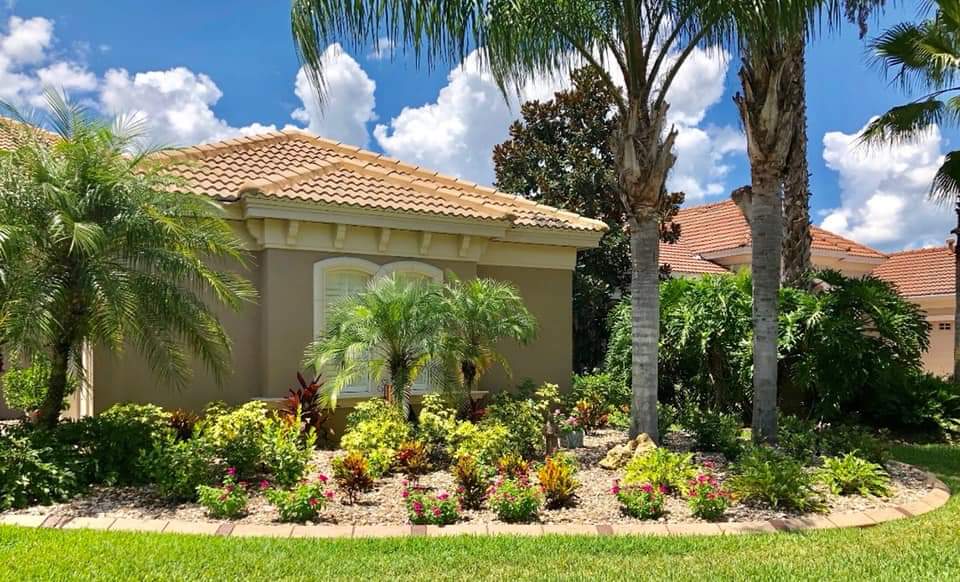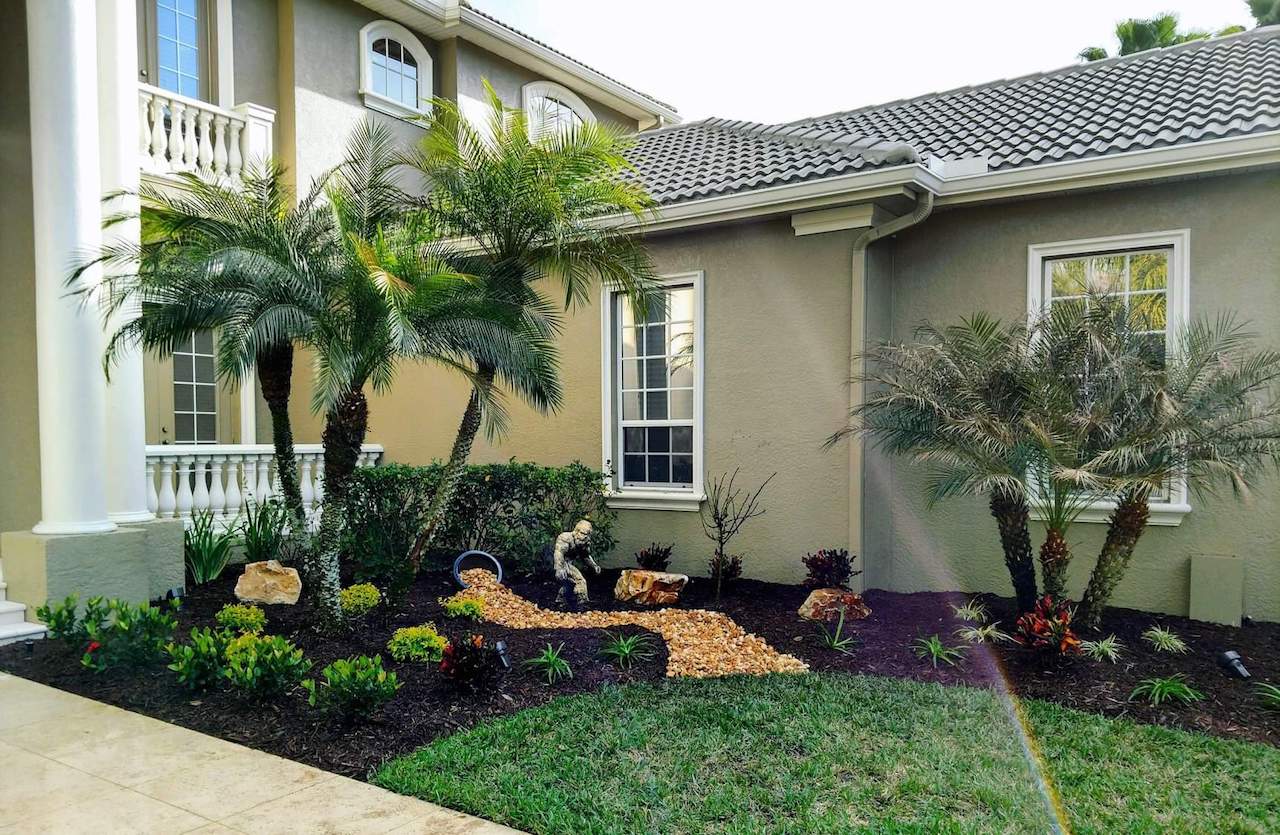Discover Creative Solutions with Professional Palm Desert Landscaping
Discover Creative Solutions with Professional Palm Desert Landscaping
Blog Article
A Comprehensive Guide to Designing and Implementing Effective Landscaping Solutions
The art and science of landscaping extend past mere aesthetic appeals; they involve a thoughtful integration of design concepts, ecological stewardship, and sensible execution. A thorough overview to effective landscaping solutions begins with an in-depth understanding of your exterior area, highlighting the significance of balance, percentage, and unity. As we explore lasting methods and the selection of ideal plants, the implications for biodiversity and area wellness become significantly apparent. What approaches can one utilize to make certain these landscapes not just flourish however also thrive in harmony with their environments?

Understanding Landscape Layout Principles
One could wonder what foundational components add to effective landscape layout. At its core, effective landscape style hinges on several vital principles that guide the setup and selection of components within an area. These concepts consist of unity, proportion, equilibrium, and rhythm, each offering to create an unified outdoor setting.
Unity refers to the natural relationship among numerous components, making certain that they interact visually and functionally. Equilibrium can be accomplished via in proportion or unbalanced plans, allowing the landscape to really feel secure and inviting. Percentage entails comprehending the range of elements in regard to each other and the surrounding atmosphere, advertising aesthetic harmony and comfort.

Evaluating Your Outdoor Space
Before carrying out the concepts of landscape design, a complete assessment of your outside room is vital. This preliminary examination aids define the range of your landscaping job and makes sure that your layout straightens with the unique qualities of your property. Begin by evaluating the dimensions of your area, taking exact dimensions to recognize the readily available location for various elements such as gardens, pathways, and patios.
Next, observe the existing features of your landscape, including topography, soil quality, and drainage patterns. These factors significantly affect plant selection and placement. Additionally, assess the sunlight direct exposure throughout various areas throughout the day, as this will impact the kinds of plants that prosper in your garden.
Consider the microclimates developed by frameworks, trees, and various other obstacles, as they can affect temperature level and dampness levels. Finally, take note of any existing plants or hardscape components that you desire to maintain or remove. This extensive examination prepares for a well-informed and reliable landscape design solution, ensuring that your layout is not only aesthetically pleasing however likewise functional and lasting for years ahead.
Sustainable Landscape Design Methods
Incorporating lasting landscaping techniques is essential for developing an environmentally liable outside room. These methods not just promote eco-friendly balance yet also boost the aesthetic and useful worth of a landscape. One foundational strategy is the usage of indigenous plants, which require much less water and maintenance while supporting neighborhood wildlife. Carrying out efficient watering systems, such as drip irrigation, minimizes water waste and makes certain that plants get adequate wetness.

One more reliable technique is the calculated positioning of trees and shrubs to offer all-natural windbreaks and color, thus decreasing energy expenses (Palm Desert Landscaping). Rainfall gardens can be incorporated right into the landscape design to handle stormwater drainage efficiently, filtering system toxins before they go into rivers
Choosing the Right Plants
Picking the right plants for your landscape is crucial to accomplishing both visual appeal and ecological harmony. The process starts with an understanding of your neighborhood environment, dirt conditions, and the specific microenvironments within your landscape. Evaluating aspects such as sunshine direct exposure, dampness degrees, and existing vegetations will certainly aid you pick plants that thrive in your unique setting.
Consider incorporating native plants, as they are well-adapted to local conditions, require less upkeep, and assistance neighborhood wild animals. In addition, picking a varied variety of types can improve biodiversity while decreasing the risk of disease and pest outbreaks. It is necessary to assess the growth habits, growing periods, and seasonal colors of potential plants to develop a cohesive and dynamic landscape.
Additionally, consider the planned usage of the area; for example, if the location will certainly experience high foot web traffic, select resilient ground covers. By attentively selecting plants that align with both your ecological requirements and aesthetic objectives, you can produce a sustainable landscape that not just improves your building however also adds positively to the surrounding ecological community.

Implementation and Maintenance Methods
Once the best plants have actually been picked for your landscape, the focus moves to efficient execution and ongoing maintenance methods. Effective installation begins with appropriate website prep work, that includes soil testing to figure out nutrient degrees and pH, followed by amending the soil as needed. Meticulously arrange plants according to their growth practices and light demands, making sure ample spacing to promote healthy growth.
Irrigation is an important component of execution. Develop a watering schedule that considers the particular needs of each plant types, adjusting for seasonal modifications. Utilizing drip irrigation systems can enhance water efficiency and reduce runoff.
Upkeep strategies need to be executed to make sure the durability and vigor of your landscape. Routine jobs include weeding, mulching, and pruning to regulate growth and avoid illness. Fertilizing needs to be conducted based on look at this web-site soil tests, providing the required nutrients without over-fertilizing.
Keeping an eye on for diseases and parasites is crucial; early discovery can stop considerable damage. Last but not least, seasonal adjustments to maintenance regimens, such as winterizing perennials and preparing for springtime development, will certainly make certain that your landscape continues to be visually attractive and healthy year-round.
Final Thought
Finally, reliable landscaping remedies require an extensive understanding of design click here for more info concepts, meticulous evaluation of exterior spaces, and the application of lasting techniques. The choice of ideal plant species plays an essential role in improving aesthetic charm and ecological strength - Palm Desert Landscaping. Effective execution and ongoing upkeep better ensure the durability and vigor of landscapes. By integrating these aspects, landscapes can be changed right into gorgeous, practical settings that promote biodiversity and contribute favorably to area well-being.
One could question what fundamental components add to effective landscape design. At its core, successful landscape design hinges on several essential principles that direct the plan and choice of aspects within an area.Choosing the right plants for your landscape is important to accomplishing both visual charm and environmental harmony. It is vital to assess the growth practices, blooming periods, and seasonal shades of possible plants to develop a dynamic and cohesive landscape.
When the best plants have been chosen for your landscape, the emphasis changes to efficient application and ongoing maintenance approaches.
Report this page